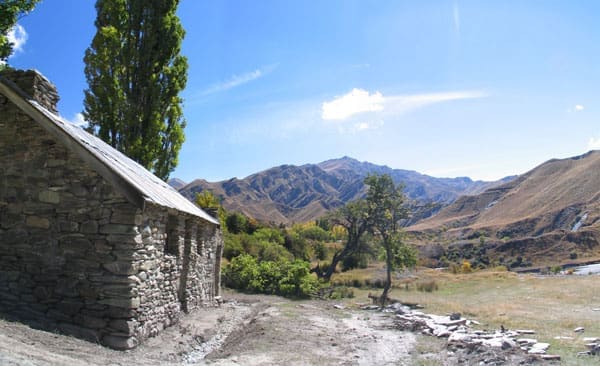Four-wheel Driving Back in Time
Lying at the end of a 15-kilometre 4WD track, visiting the abandoned gold-mining village of Macetown is as much about the journey as the destination.
The road to the historic mining village of Macetown is made for four-wheel driving. Rough, winding and rugged, it crosses the Arrow River an unforgettable 23 times, which prompts a lot of shrieking as water funnels over the bonnet of our borrowed 4WD.
As we bounce along the 15-kilometre-long track from Arrowtown, I can’t decide whether our friend is incredibly generous or immensely foolish to have lent us his truck for the day. An Otago local, he may have become complacent about the challenges this road presents, but a collection of battered number plates near one of the fords is a timely reminder that not all vehicles make it out in one piece.

As the road climbs steeply upwards, we’re squeezed between sheer rock faces and thrust around blind bends, which drop terrifyingly down to the river. Fortunately, we only meet one other vehicle – a ute driven by a young guy who’s relaxed enough to wave – and two mountain bikers considering how they’ll tackle a river crossing.
Along the way, we spy a collection of gold mining relics – water races, sluice faces, tunnels, chimneys and a hut belonging to a miner known as Opium Bob. These were built by prospectors who came to the area in the 1860s after gold was discovered in the Arrow catchment. Starting out as a canvas town, Macetown grew to boast a bakery, school, store, hall, telegraph office and two hotels, with all supplies lugged along this track on foot or by mule. At its peak, it was home to 1,500 people.
The gradient levels out as we reach what’s left of this once-thriving settlement and turn the engine off. After the hair-raising journey to get there, the DOC-managed historic reserve feels surprisingly parklike and serene, replete with stately trees resplendent in autumn colours.

Making our way to an old stone cottage, we help ourselves to apples from a hardy tree growing nearby. As I bite into mine, I try to imagine what life would have been like for the person who planted this tree – isolated, tough, unpredictable, and bitterly cold in winter.
At the cottage, and on other structures around the reserve, the history of Macetown is brought to life through a series of information panels, which tell the story of Jack Glasson, a fictional character whose tale is based on real incidents and anecdotes. As well as installing these boards, DOC has restored many of the original structures, including Andersons Battery, Needhams Cottage and Smiths Bakehouse.
Exploring over, we head to the river, hired pans in hand, to try our luck at gold-panning. Although fortune (unfortunately) isn’t on our side, it’s a peaceful pastime and we leave feeling relaxed and ready to take on the 23 river crossings that lie between us and lunch.
Travel Details
The road to Macetown is suitable for four-wheel-drive vehicles only and takes about one hour each way to drive, depending on weather and conditions. If you don’t have your own 4WD (or a generous friend who will lend you one), local operators such as Nomad Safaris and Pure Glenorchy offer guided tours. A return trip takes around four to five hours and includes refreshments and gold panning.
If you have more time (and energy), you can walk (three to four hours each way) or mountain bike (one to two hours each way, Grade 3 – Intermediate) from Arrowtown. The track links with the multi-day Motatapu Track. There is also a basic DOC campsite at the reserve.
If you’re making your own way to Macetown and want to try your hand at gold panning, you can hire pans from the Lakes District Museum or Dudley’s Precinct next to the Chinese Mining Village in Arrowtown.
Find out more about Macetown on the DOC website.

